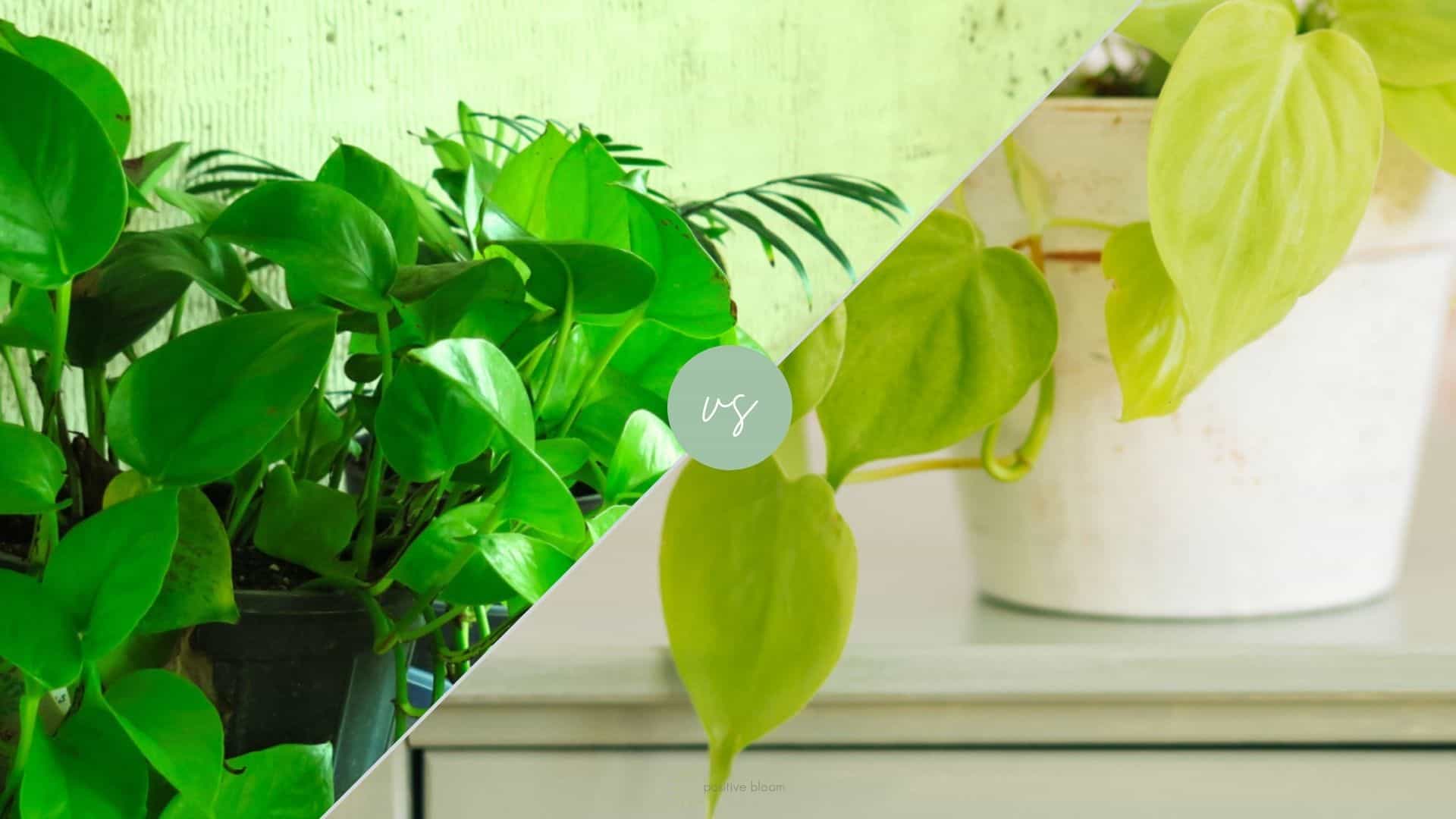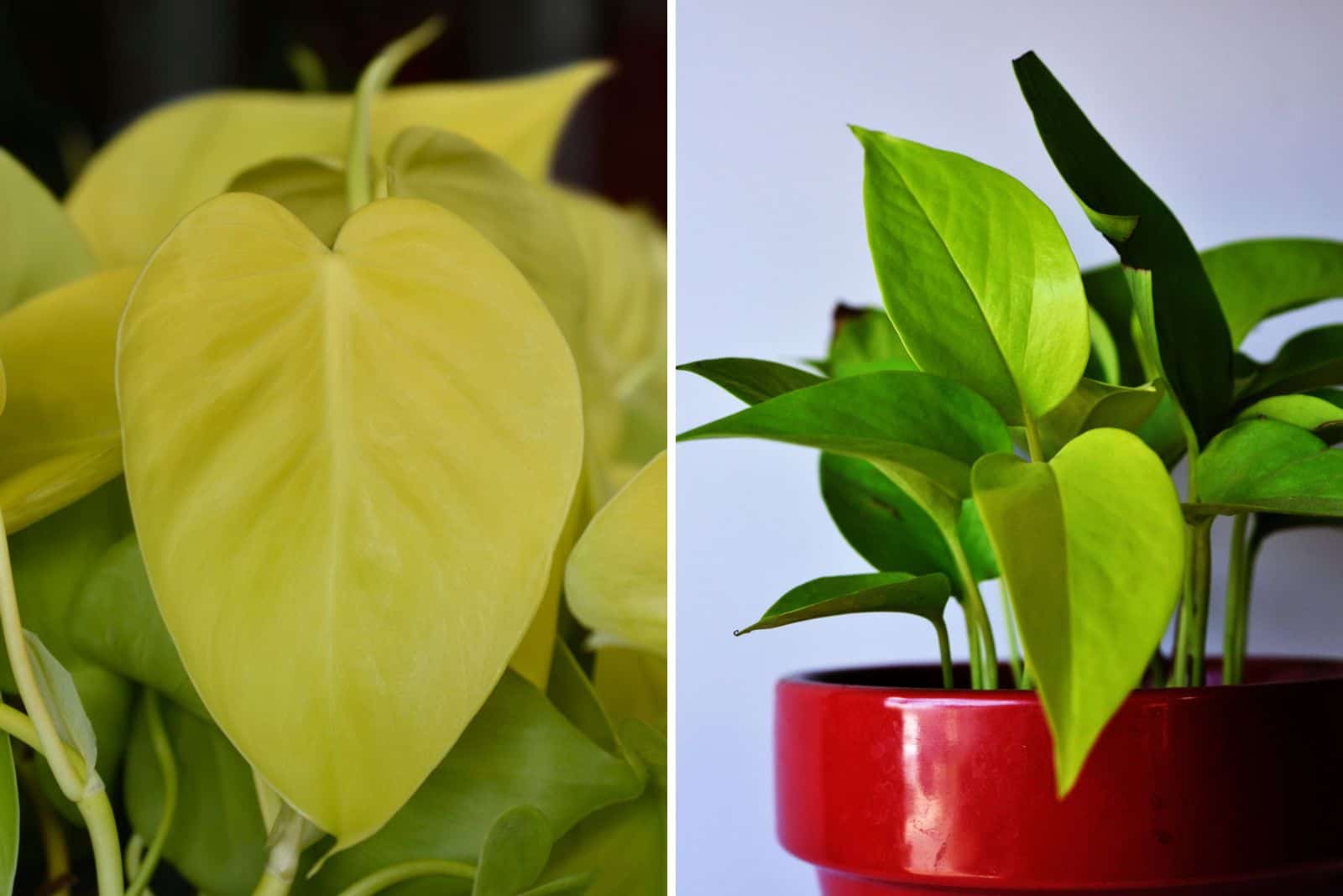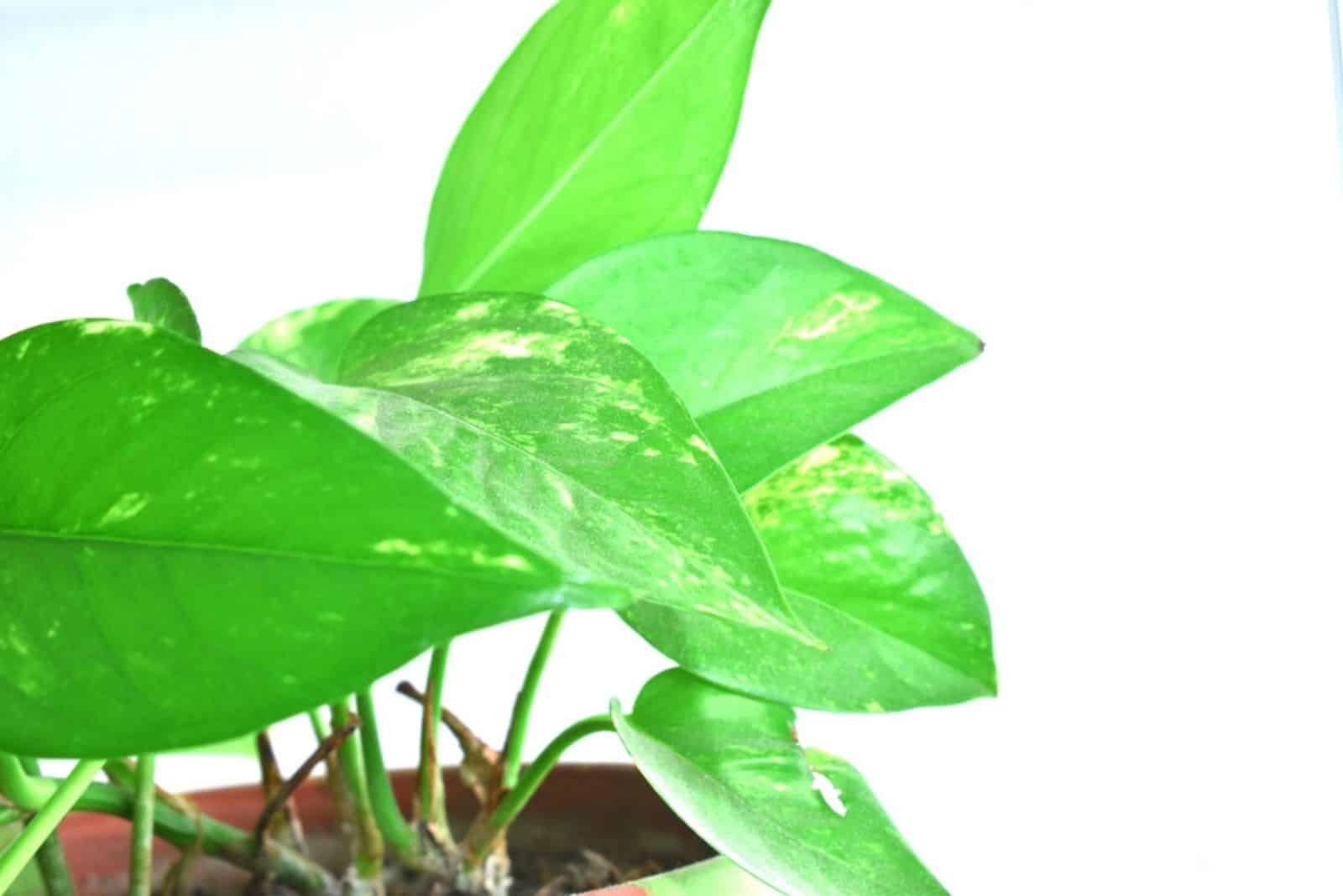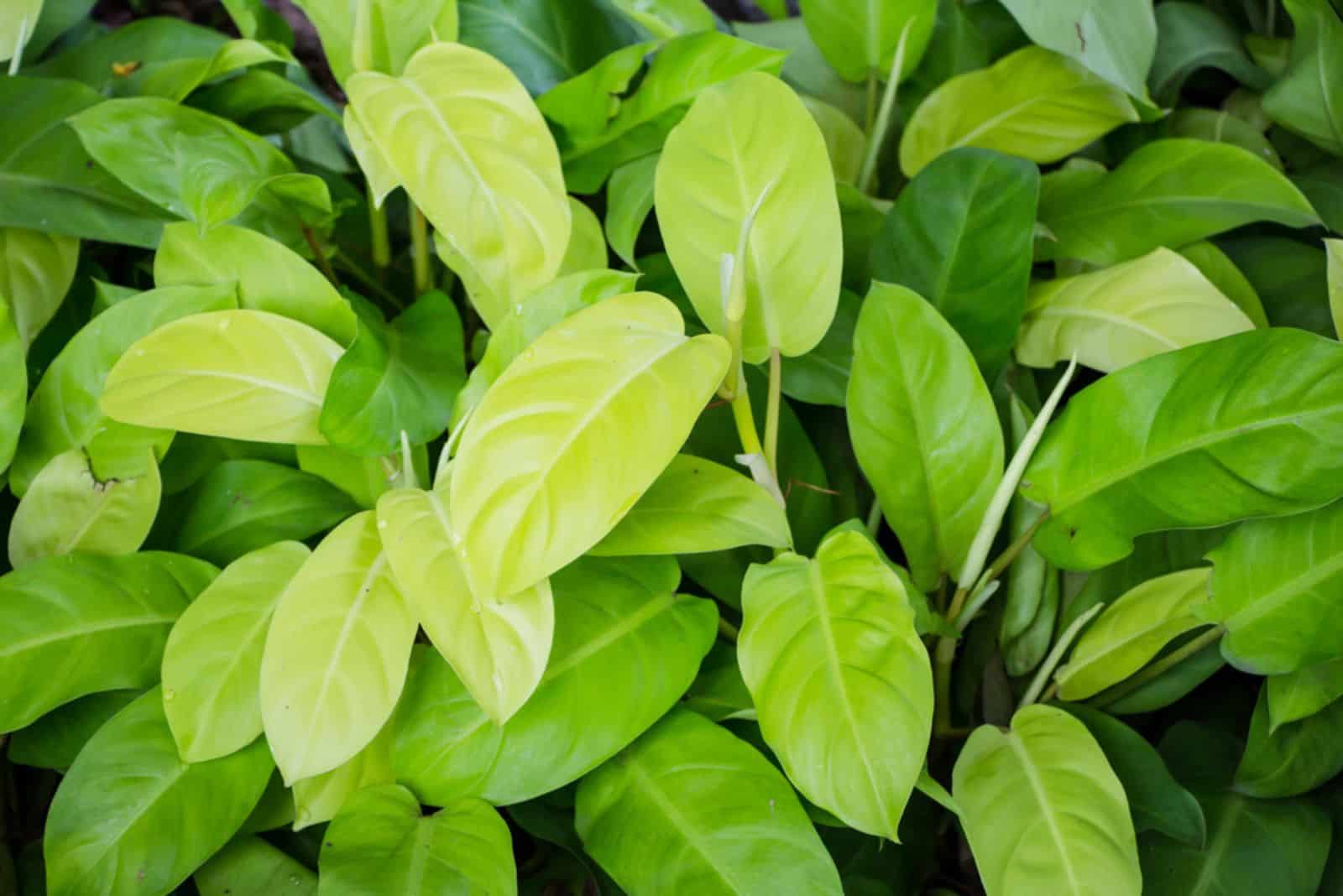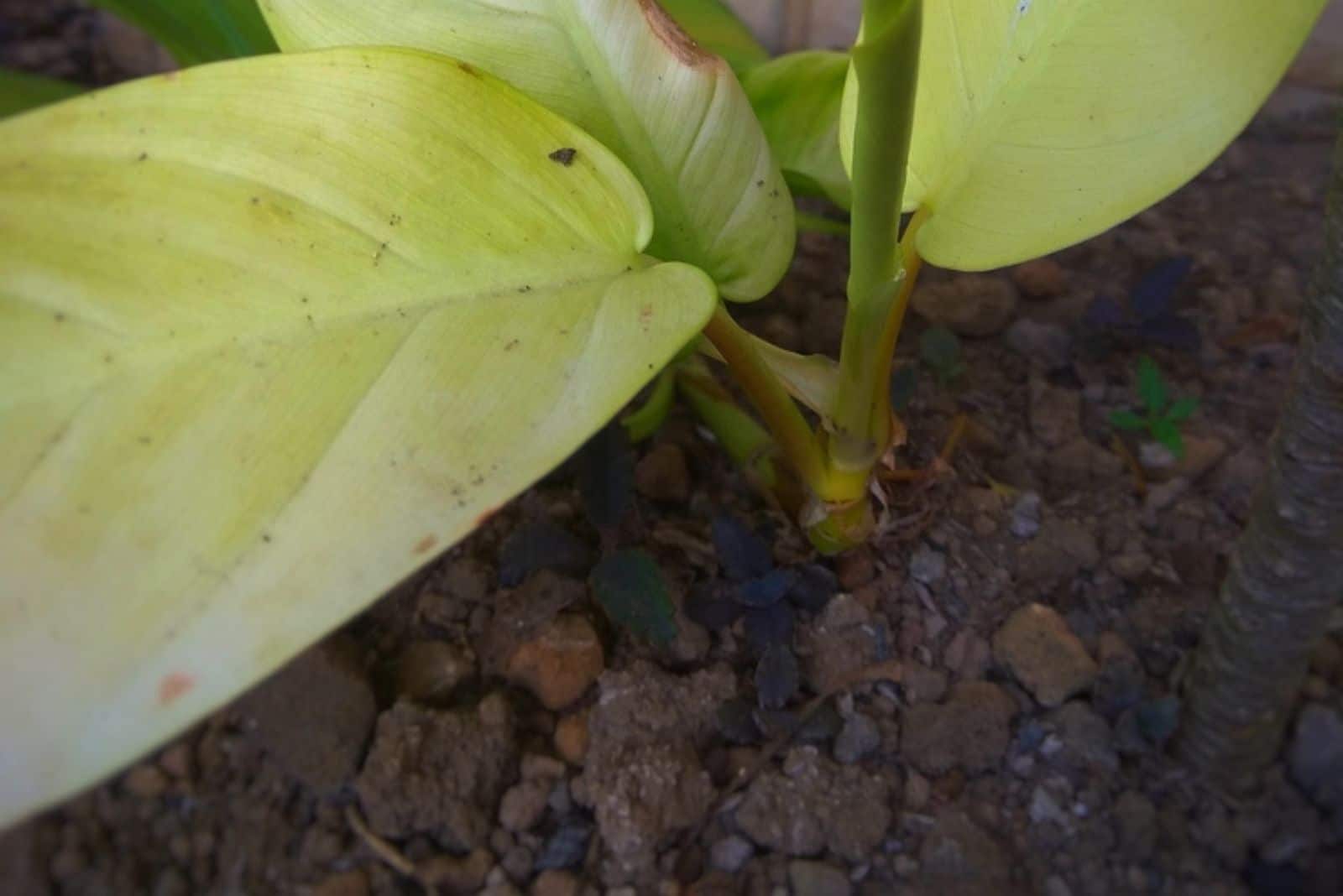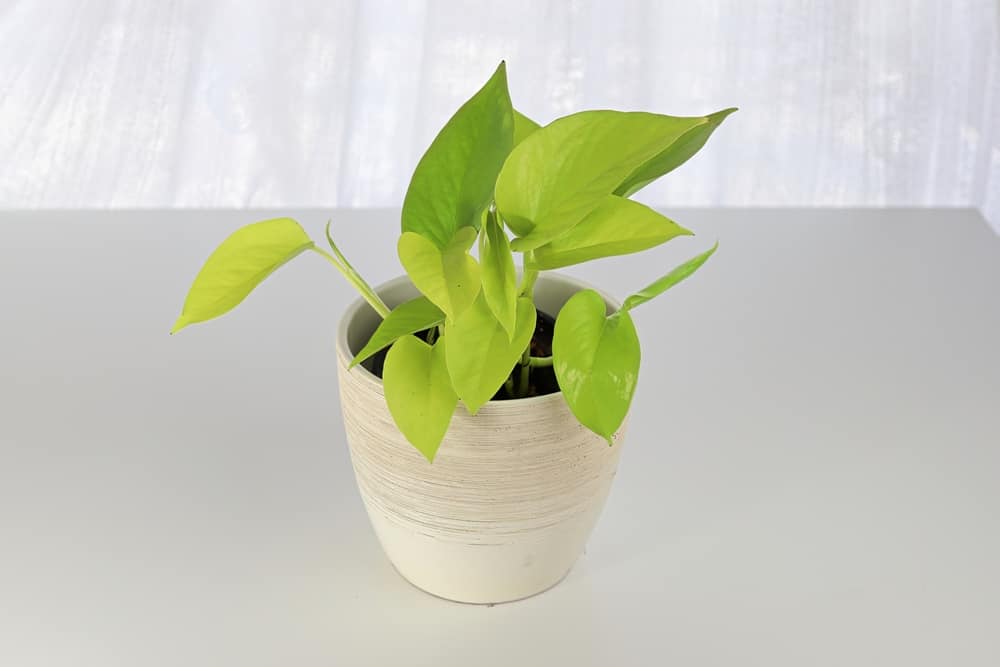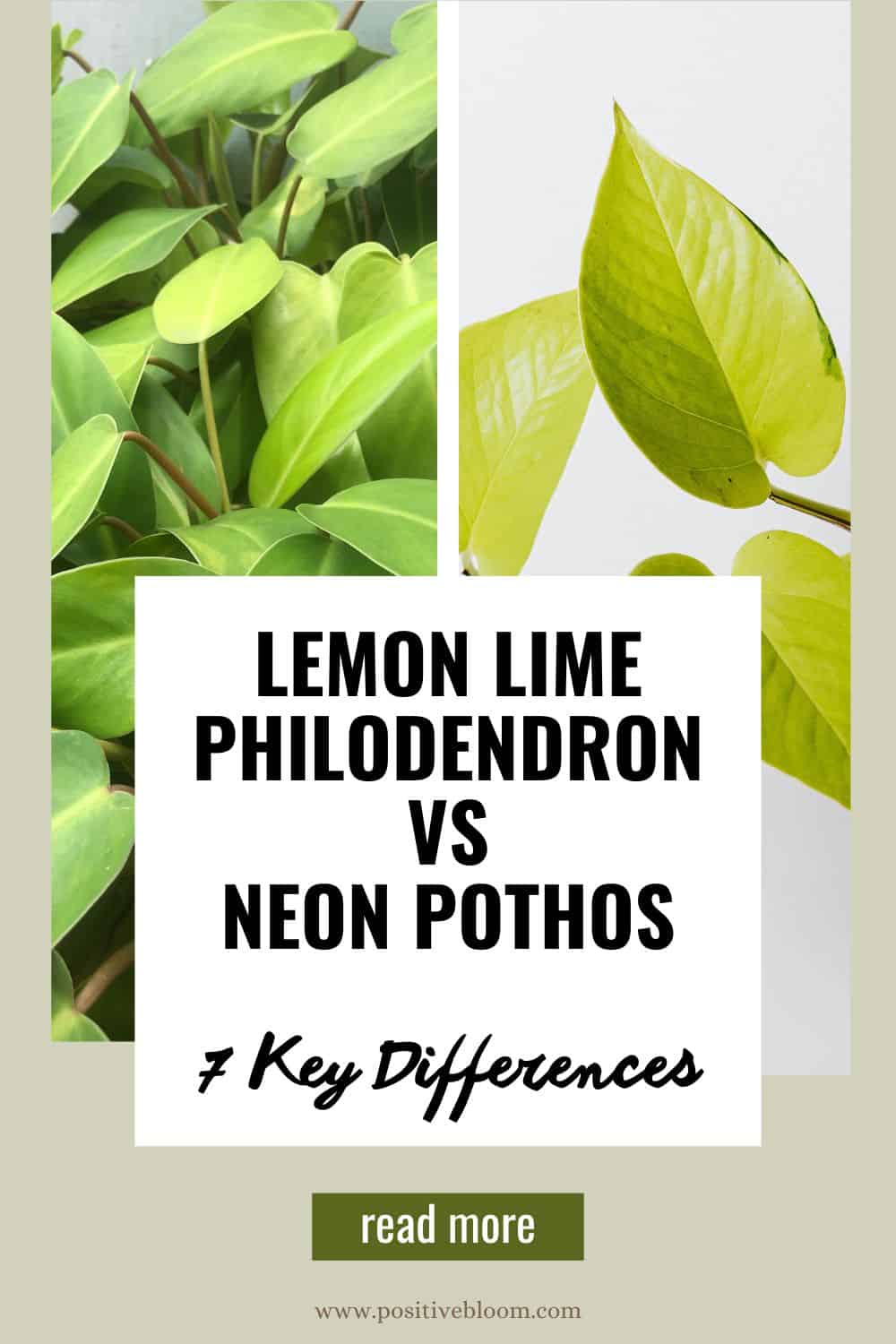Many growers choose vining pothos or philodendron species as they both look amazing and are pretty easy to maintain.
Interestingly, many of these growers, especially beginners, are often unsure if they have a philodendron or a pothos plant.
The biggest confusion is between two species: the Lemon lime philodendron and the Neon pothos plant.
Both plants indeed look similar, but actually differ in many ways.
To resolve the confusion, I’ll list all the differences between Lemon lime philodendron vs Neon pothos.
Let’s get started!
Lemon Lime Philodendron vs Neon Pothos
Pothos and philodendrons are often mistaken, but it seems that the Lemon lime philo and Neon pothos are the two species that cause the most confusion.
The essential thing to understand is that these two are completely different species. The lemon lime philodendron and Neon pothos differ in shape and texture of the leaves, leaf size, leaf color, overall size, and growth habit.
Here’s a table with a short overview of the differences between philodendron Lemon lime and Neon pothos:
[table id=537 /]
Let’s get into details!
1. Taxonomy
Taxonomic background is the first thing we need to consider when we identify species. As for the Neon pothos and Lemon lime philodendron, there are many similarities in taxonomy.
For example, these two species belong to the Plantae kingdom and are part of the Alismatales order. Regarding plant family, both Lemon lime philo and neon pothos belong to the Araceae family, i.e., the family of aroid plants.
The next classification in taxonomy is the genus, and that’s the part we are interested in now. So, the Lemon lime philodendron is a part of the large Philodendron genus and is a cultivar of the well-known Philodendron hederaceum aka Heartleaf philodendron.
On the other hand, Neon pothos is a part of the Epipremnum genus. It is a cultivar of the very popular Epipremnum aureum species.
As you can see, when we talk about Lemon lime philo and Neon pothos, we are referring to different plants.
2. Shape And Texture Of The Leaves
Now we come to the first ‘visible difference’, leaf shape and texture. When you take a look at both species, you can see that they have heart-shaped leaves.
If you look a little closer, you’ll notice that Lemon lime philodendron leaves are more heart-shaped, and their texture also differs from the texture of the Neon pothos leaves.
When you touch the Lemon lime philodendron leaves, you’ll notice they have a softer texture. In contrast, the leaves of the Epipremnum aureum are waxier. Additionally, the Neon pothos has thicker leaves.
Now look at the petiole (a stalk that links the leaf blade to the stem) of both species.
The lemon lime philodendron features a spherical petiole, whereas the neon pothos petiole is curved inwards toward the stem.
The second difference when it comes to the petiole is that the Lemon lime philo petiole is thinner than that of the neon pothos plant.
3. Size Of The Leaves
If you take a look at the leaf base of these two species, you will see that Epipremnum aureum Neon leaves have a flat base, and the Lemon lime philo leaf base is rounded.
The leaves of the Philodendron hederaceum Lemon lime are broad and can be from 7 to 10 inches long and around half an inch wide. The leaves of the neon pothos are longer and thinner.
4. Leaf Color
The foliage color of these species earned them the nicknames Neon and Lemon lime.
The Epipremnum aureum Neon features vivid neon green leaves, hence the name. As for the philodendron Lemon lime, the leaves have a more muted lime green tint.
You’ll also notice a light pinkish or brownish hue on the leaves of the Philodendron hederaceum Lemon lime.
5. Plant Size
The overall size of mature plants can help us differentiate between philodendron Lemon lime vs Neon pothos.
Both species look impressive when grown in hanging baskets, but believe it or not, the vines of the Epipremnum aureum neon can reach 10 feet in length.
But you’ll need to wait quite a long time until your Neon pothos plant reaches this size.
6. Growth Habit
The two plants have quite distinct growth patterns, and they typically develop at various rates and times of the year.
The Philodendron hederaceum Lemon lime often grows all year long, and the growth rate doesn’t decrease during the winter, so it needs regular trimming. Additionally, these philodendrons display more compact growth, so make sure you don’t skip pruning.
In order to save energy, the Epipremnum aureum Neon frequently grows very swiftly in the summer months and more slowly in the winter.
Both species have different rates of root development, which has an impact on how quickly they grow as a whole.
The Neon pothos plant has a more controlled growth habit since each node only has one sturdy aerial root.
The Philodendron Lemon lime, on the other hand, produces smaller roots. Still, it may develop several roots on each node that create a more jungle-like image when fully grown.
7. Growing Conditions
The Neon pothos thrives in indirect sunlight, and this can be achieved indoors by filtering the sunlight and creating partial shade.
You can get indirect light by blocking the direct sun with drapes, window coverings, or other opaque surfaces.
If you want a plant that grows better in low light, the philo Lemon lime is a better choice.
The optimal soil pH for the Philodendron hederaceum Lemon lime is from 6.5 to 7.5. The Epipremnum aureum Neon prefers slightly acidic soil with a pH ranging between 6.0 and 6.5.
Another difference in growing requirements is drought resistance. If you are looking for a plant that you don’t need to water often, then the Neon pothos is perfect. Its drought-tolerance makes it an excellent plant for beginner growers.
As for philodendron plants, you’ll need to create a specific watering schedule and make sure you don’t skip irrigation.
Philodendron Lemon Lime And Neon Pothos Plant Similarities
Generally speaking, these two popular houseplants look almost exactly the same if you don’t look too close.
The heart-shaped leaves, distinctive green color, and vining growth habit may trick us into thinking that these two are the same plants.
We’ve seen the main differences, and now it’s time to learn what makes these plants so similar in terms of growing requirements and features.
Watering Requirements
I mentioned that Lemon lime philodendrons are less drought-tolerant, so you shouldn’t leave them without water.
But it’s also important to note that the Neon pothos needs constantly moist soil to thrive. It will survive shorter periods of drought, but this is a pothos not a succulent plant, and an underwatered pothos isn’t something you want to deal with.
However, leaving it without water for some time is better than overwatering your pothos, which will have even more serious consequences.
Just to be safe, always check the moisture content of philodendron or pothos soil before you add more water.
Light Conditions
As mentioned, the Lemon lime philodendron will adapt faster to low-light conditions. Low light won’t kill your neon pothos, but it may take more time to adapt. Your pothos may display leaf curl and stunted growth if it lacks light.
Regarding both species’ light requirements, we must remember that these are tropical plants that grow under the tree canopy, which means they don’t receive direct light.
Soil Requirements
Both species favor a loose, well-draining soil blend. Choosing the right potting mix will help you avoid water pooling below the topsoil and decrease susceptibility to root rot.
I recommend amending the potting soil with peat moss and perlite to improve water retention and also aid drainage.
Fertilizer Requirements
I especially like these fast-growing plants because they aren’t heavy feeders. Trust me; you don’t want your first plant to be constantly hungry and suffer poor growth due to a lack of nutrients.
The growing season for both species starts in early spring and lasts until the end of the summer. You can dilute all-purpose liquid fertilizer and feed your philodendron or pothos once a month during the growing season.
Temperature Requirements
Both plants are native to tropical climates, which means they require higher temperatures and are not cold hardy.
If you live in USDA hardiness zones 11-12, you can grow a Neon pothos or Lemon lime philodendron outdoors.
In all other zones, grow these plants indoors in a temperature range from 65 to 80 degrees Fahrenheit during the daytime and around 55 degrees Fahrenheit during the night.
Neither plant can survive temperature fluctuations, so you should keep them away from heating devices such as radiators.
Toxicity
We’ve seen so many remarkable features of the Neon pothos and Lemon lime philodendron plants, but nothing is perfect.
All types of pothos and philodendron, including the Philodendron hederaceum Lemon lime and Epipremnum aureum Neon, are toxic to humans and pets!
These species contain calcium oxalate crystals that activate upon consumption.
Make sure you keep your Neon pothos or philodendron Lemon lime where your children or pets can’t reach them, as ingestion could lead to several issues, such as mouth and throat swelling, oral irritation, and vomiting.
Pest Susceptibility
If you decide to grow a Neon pothos or Lemon lime philo indoors, you need to know that pests like to suck the sap out of the leaves of these plants.
The most common are mealybugs and scale insects, but if you spot them on time you can fix the issue with neem oil.
FAQs
What is the best pothos variety for beginners?
All pothos varieties are pretty easy to maintain and won’t cause you much trouble. If you are new to gardening, I recommend the most common varieties, such as Golden pothos (Epipremnum aureum), Marble queen (Epipremnum aureum Marble queen), or Hawaiian pothos (Epipremnum aureum ‘Hawaiian’).
Pothos come from the family of flowering plants, and you’ll see magnificent blooms in their natural habitat, but you’ll rarely see white flowers indoors.
What are the benefits of pothos?
Low care requirements are by far the best feature of pothos plants. But that’s just the beginning! If you have only one pothos, you can quickly get many more because the stem-cutting propagation method has a very high success rate.
Pothos is one of the houseplants that produces the most oxygen. Also, Epipremnum aureum plants are air purifiers, and will clean indoor air of harmful substances like formaldehyde, benzene, and carbon monoxide.
NASA research on the Golden pothos has shown that these plants help increase indoor humidity.
These medium-sized plants will look amazing wherever you place them. If you are into Feng Shui, you’ll also be happy to hear that these plants remove negative energy.
As per Vastu, pothos species will attract good luck to your home.
What is the scientific name of philodendron?
The term Philodendron refers to the genus of plants in the Araceae family (aroids). The name is a blend of two Greek words, philo (love) and dendron (tree).
Therefore all species will have the term philodendron in their scientific name. For example, the scientific name for the Splendid philodendron is Philodendron verrucosum x melanochrysum, as it’s a hybrid of two philodendron species.
The most common philodendron, the Heartleaf philodendron, is scientifically known as Philodendron hederaceum.
Wrapping Up
Philodendrons and pothos have adorned households for ages, and it seems like this won’t be changing any time soon.
Both species look magnificent, and since they’re easy to maintain, they’re one of the most common houseplants. The fact is that these plants look alike, and many growers don’t even know which type they actually have.
Now that you’ve seen the differences between Lemon lime philodendron vs neon pothos, I’m sure you’ll find a place in your home for one species (or both).
One more thing; keep your philodendrons and/or pothos plants out of reach of pets and children as they are toxic.
Until next time!
Like this post? Share or pin it for later!

